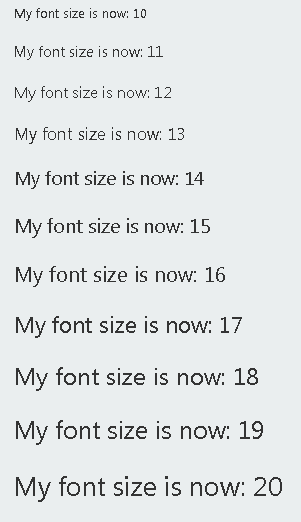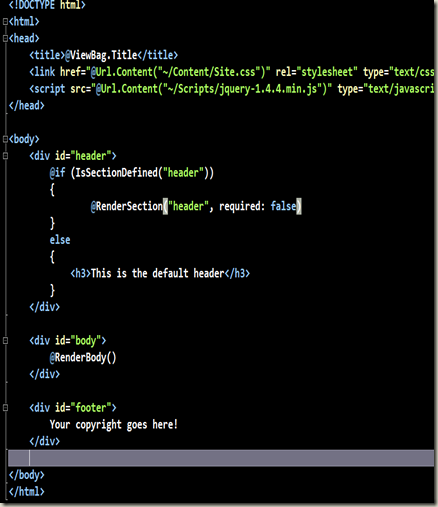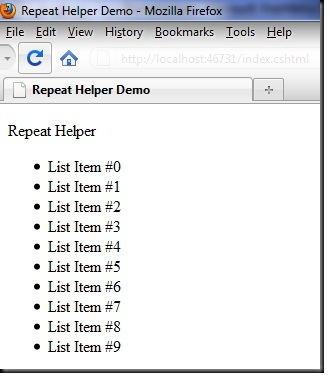Orchard: Razor介绍
Orchard 使用模板来显示shapes,模板类似ASP.MVC的partial views概念。Shapes 是一个包含模型数据的动态对象,模板可以包括HTML标记代码片段、CSS样式、JavaScript等。视图引擎负责解析模板并且把shape显示在web页面。Orchard的默认视图引擎是Razor,本文介绍一下Razor。
Razor语法是一个服务器端web页面标记语言,代码在服务器端运行生产HTML或者其他格式,然后发送到浏览器端。Razor支持C#和VB语言,文件扩展名为.cshtml 或.vbhtml。服务器能够识别这些后缀名,运行这些代码展现shape。
如果你想体验一下Razor 语法,我们推荐你使用WebMatrix。WebMatrix 是一个使用Razor语法生成ASP.NET Web页面的免费开发环境。它包括IIS Express (一个开发下的a development web server)、ASP.NET和SQL Server Compact (一个嵌入式)。
WebMatrix 支持Razor 语法高亮,Microsoft也会在VS2010 Pack上加上这个功能。下载链接:WebMatrix download page

代码块和内置表达式
使用@添加代码,大括号 ({ }) 用来放置代码块。例如下面把"Hello World" 设为myMessage变量:
@{ var myMessage = "Hello World"; }
下面是一个稍微复杂一点的代码块:
@{
var greeting = "Welcome to our site!";
var weekDay = DateTime.Now.DayOfWeek;
var greetingMessage = greeting + " Today is: " + weekDay;
}
<p>The greeting is: @greetingMessage</p>

注意: 不鼓励使用内置样式,尽量使用CSS。
当代码块包含一个简单的表达式,例如for,你可以在关键字之前加上@表示这是代码,而不需要添加大括号。例如下面:
for(var i = 10; i < 21; i++)
{
<p style="font-size: @(i + "pt")">My font size is now: @i</p>
}

几个提示
- 使用@添加代码
- 使用大括号{}写代码块
- 在代码块中,每个代码都是分号;结束
- 使用变量保存值
- 使用双引号加入字符串
- 代码区分大小写
- 代码经常会使用一些对象,例如Request
更多内容可以参考: Introduction to ASP.NET Web Programming Using the Razor Syntax
Razor解析器
参考:http://tech.ddvip.com/2010-08/1282202894159226.html
它实际上分为三个独立的组件:
- 理解基础HTML语法的标记解析器;
- 理解基础C#或者VB语法的代码解析器;
- 理解标记和代码如何混合的中央控制器
Razor解析器有三个参与者:代码解析器,标记解析器,代码解析器。三个组件相互配合,协同工作完成对Razor文档的解析。Razor解析器有三种状态,分别是:解析标记文档、解析标记块,解析代码块,任何情况下解析器都处在以上三种状态中的一种状态上。前两种状态由标记解析器来处理,最后一种状态由代码解析器处理。
文件内容如下:
<ul>
@foreach(var p in Model.Products) {
<li>@p.Name ($@p.Price)</li>
}
</ul>
标记解析器接着调用代码解析器,让其来解析代码块。在Razor中块为单独的一段代码或者是有明确开始结束字符序列的标记,因而此处的"foreach" 声明是代码块,它以字符"f"开始,以字符"}"结束。代码解析器非常清楚C#语法,他会跟踪C#指令,当遇到"<li>"字符序列的时候, 它知道此处应该是C#指令的开始,但C#并不支持这样的指令,因而代码解析器会再次调用标记解析器来解析接下来的HTML代码块。这样在代码和标记解析器 之间创建一种从标记解析开始,进入代码解析,然后再进入标记解析….的递归过程。
我们可以从中看出ASPX和Razor的区别:在ASPX文件中,代码和标记可以看作是两个并行的流,我们写一些标记然后跳过去写一些代码,再跳回来写标记,如此进行;而Razor文件更像是一棵树,我们写一些标记,然后在标记里面写一些代码,再在代码中嵌入标记….。
到目前为止,解析器内的调用栈应该类似于以下结构(省略了一些帮助方法):
HtmlMarkupParser.ParseDocument()
CSharpCodeParser.ParseBlock()
HtmlMarkupParser.ParseBlock()
所以我们仅需要调用标记解析器去解析"<li>"和"</li>"之间的标记块,在没有到达"</li>"之前解析器认为标记块还没结束,哪怕在标记之间有"}"字符都不会打断"foreach"声明。
当解析"<li>"的时候,标记解析器发现了"@"字符,因而代码解析器会被调用,此时栈结构变成:
HtmlMarkupParser.ParseDocument()
CSharpCodeParser.ParseBlock()
HtmlMarkupParser.ParseBlock()
CSharpCodeParser.ParseBlock()
启动代码
在View每次渲染前,都会执行_ViewStart.cshtml的代码:
Layout

参考:http://www.cnblogs.com/lengleng3898/archive/2010/07/21/Introduce_Razor.html
先说RenderBody。当我们在母版页中的某个位置写了@RenderBody()后,接下来在使用母版页时,只需在页面的顶部写入:
@{ LayoutPage = "MasterPageLocation"; }
MasterPage:

Page:

使用RenderSection时需要指定Section片断的名字, 我们可以在母版页中的相关位置上写上@RenderSection("name"),然后在使用母版页的页面中声明类似的Section,即:@section header {/*HTML or other*/},具体如下:
MasterPage:

Page:

内联模板
我们可以使用内联模板来创建自己的模板帮助类。
- Repeat实现代码
 View Code
View Code
@using System.Text;
@functions {
public static IHtmlString Repeat(int times, Func<int, object> template) {
StringBuilder builder = new StringBuilder();
for(int i = 0; i < times; i++) {
builder.Append(template(i));
}
return new HtmlString(builder.ToString());
}
}
- 模板
 View Code
View Code
<!DOCTYPE html>
<html>
<head>
<title>Repeat Helper Demo</title>
</head>
<body>
<p>Repeat Helper</p>
<ul>
@Repeat(10, @<li>List Item #@item</li>);
</ul>
</body>
</html>
- 显示结果

配置
参考:http://www.cnblogs.com/n-pei/archive/2011/01/23/1942711.html
关于Razor的配置,你可以看到它会在Web.Config中有一个单独的section来存放Razor的configuration:
如果你在其它例如web form中使用Razor,记得添加这部分配置。
生成Shape模板
Orchard:使用VS2010来生成一个地图Content Part
<img alt="Location" border="1" src="http://maps.google.com/maps/api/staticmap?
&zoom=14
&size=256x256
&maptype=satellite&markers=color:blue|@Model.Latitude,@Model.Longitude
&sensor=false" />
@model Maps.Models.MapPart
<fieldset>
<legend>Map Fields</legend>
<div class="editor-label">
@Html.LabelFor(model => model.Longitude)
</div>
<div class="editor-field">
@Html.TextBoxFor(model => model.Latitude)
@Html.ValidationMessageFor(model => model.Latitude)
</div>
<div class="editor-label">
@Html.LabelFor(model => model.Longitude)
</div>
<div class="editor-field">
@Html.TextBoxFor(model => model.Longitude)
@Html.ValidationMessageFor(model => model.Longitude)
</div>
</fieldset>
Layout 和Document模板
layout 和 document 模板是定义一个Web页面结构的特定模板,这些特定模板通常使用在主题中进行页面布局。每个页面都有一个Layout shape 与它关联。这个Layout
shape 定义了一些可以容纳web页面内容的zones。layout 和document 模板决定如何摆放zones。
layout 模板(Layout.cshtml)摆放zones在页面上,文档模板(Document.cshtml)摆放在Web剩余地方。缺省情况下,Layout
shape 为文档模板定义了三个zones(Head, Body,
Tail)和一个layout模板(Content)的shape。在文档模板中,Head zone 用来定义Web页面的header,Body zone用来插入layout 模板,Tail zone用来放置页面脚注。
下面为一个典型的文档模板:
@using Orchard.Mvc.Html;
@using Orchard.UI.Resources;
@{
RegisterLink(new LinkEntry {Type = "image/x-icon", Rel = "shortcut icon",
Href = Url.Content("~/modules/orchard.themes/Content/orchard.ico")});
Script.Include("html5.js").AtLocation(ResourceLocation.Head);
var title = (Request.Path != Request.ApplicationPath && !string.IsNullOrWhiteSpace((string)Model.Title)
? Model.Title + WorkContext.CurrentSite.PageTitleSeparator
: "") +
WorkContext.CurrentSite.SiteName;
}
<!DOCTYPE html>
<html lang="en" class="static @Html.ClassForPage()">
<head>
<meta charset="utf-8" />
<title>@title</title>
@Display(Model.Head)
< script>(function(d){d.className="dyn"+d.className.substring(6,d.className.length);})(document.documentElement);</script>
</head>
<body>
@* Layout (template) is in the Body zone at the default position *@
@Display(Model.Body)
@Display(Model.Tail)
</body>
</html>
下面示例显示了一个典型的布局模板。
@* Html.RegisterStyle("site.css"); *@
@{
Model.Header.Add(Display.Header(), "5");
Model.Header.Add(Display.User(), "10");
Model.Header.Add(Model.Navigation, "15");
}
<div id="page">
<header>
@Display(Model.Header)
</header>
<div id="main">
<div id="messages">
@Display(Model.Messages)
</div>
<div id="content-wrapper">
<div id="content">
@Display(Model.Content)
</div>
</div>
<div id="sidebar-wrapper">
<div id="sidebar">
@Display(Model.Sidebar)
</div>
</div>
</div>
<div id="footer-wrapper">
<footer>
@Display(Model.Footer)
</footer>
</div>
</div>
Name: SimpleTheme
Author:
Description: Simple example theme.
Version: 1.0
Tags: Simple
Website: http://www.orchardproject.net
Zones: Header, User, Navigation, Messages, Content, Sidebar, Footer
推荐:你可能需要的在线电子书
我的新浪围脖: http://t.sina.com.cn/openexpressapp 敏捷个人sina围裙:http://q.t.sina.com.cn/135484
欢迎转载,转载请注明:转载自周金根 [ http://zhoujg.cnblogs.com/ ]



















【推荐】国内首个AI IDE,深度理解中文开发场景,立即下载体验Trae
【推荐】编程新体验,更懂你的AI,立即体验豆包MarsCode编程助手
【推荐】抖音旗下AI助手豆包,你的智能百科全书,全免费不限次数
【推荐】轻量又高性能的 SSH 工具 IShell:AI 加持,快人一步
· 如何编写易于单元测试的代码
· 10年+ .NET Coder 心语,封装的思维:从隐藏、稳定开始理解其本质意义
· .NET Core 中如何实现缓存的预热?
· 从 HTTP 原因短语缺失研究 HTTP/2 和 HTTP/3 的设计差异
· AI与.NET技术实操系列:向量存储与相似性搜索在 .NET 中的实现
· 10年+ .NET Coder 心语 ── 封装的思维:从隐藏、稳定开始理解其本质意义
· 地球OL攻略 —— 某应届生求职总结
· 提示词工程——AI应用必不可少的技术
· Open-Sora 2.0 重磅开源!
· 周边上新:园子的第一款马克杯温暖上架